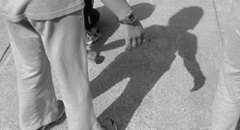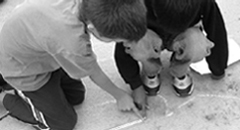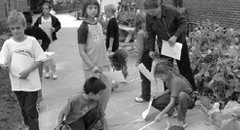
|

|

|
This map represents a collective landscape of the work of the 2003-2005 MLV Seminar. It contains clusters of questions and ideas that arose during the individual and collective work of the seminar. We do not consider the map complete; rather, the concepts to which it refers, our relationships to them, and the map itself are all likely to change as our individual and group work continues.
The Intentionality of the Group
The degree of intentionality in terms of who is in the group and why it has come together is part of what makes a learning group distinct from other types of groups.
- Composition of the Group
Factors that influence how a learning group functions and learns include the size of the group; the abilities and interests of its members; friendships; racial, ethnic, and socio-economic make-up; and whether membership is voluntary. What are other factors, and which combinations enhance the functioning and learning of the group?
- Purpose of the Group
Why the group has come together—in relation to what purpose, project, problem, or topic of study—is a key part of the group's identity.
The Development of Group Learners and Learning Groups
How do individual learners' developmental stages influence the formation, functioning, and demonstration of understanding of learning groups? What is the developmental trajectory of the learning group itself?
- Group Learning across the Life Span
- Development of the Learning Group
Culture, Values, and Democracy
What are the cultural challenges that limit our ability to consider new possibilities and opportunities for individual and group learning? Which aspects of culture support individual and group learning?
- Cultural Challenges in the U.S. Context
Cultural challenges in the U.S. include assumptions, values, and beliefs about the relationship between individual and group; the nature of teaching, learning, and assessment; images of the child; and the role of school in the transmission of culture and knowledge. One question that keeps emerging is how to conduct this work in the context of high-stakes testing.?
- Diversity, Equity, and Learning Groups
Giving adequate regard to the socioeconomic and cultural background of the individuals in a group can optimize opportunities for learning and increase the chances that all members feel invited to contribute to and receive from the group.
The Relationship between Individual and Group
Learning is the result of both individual and group activity. Learning in groups is essential to how individual learning is constructed; learning groups can also solve problems and create products that no individual alone could achieve.
- Choosing Tasks for Groups and Individuals
Which tasks are best suited for individual learning and which for group? Some students make distinctions between group work and group learning.
- Movement and Balance between Individual and Group
What is the nature of the movement and balance between individual and group work, and small and large group work?
- Potential Tensions between Community and Learning
What do you do if there is a tension between community-building (including everyone's ideas) and learning? When an individual's ideas are not aligned with the group's, what do the individual and the group do?.
How Learning Groups Function
How do learning groups function? What do they look like?
- Emotional and Aesthetic Dimensions of Group Learning
The aesthetic dimension of learning can be thought of as including the set-up of space and choice of materials, the design of the learning process, and the nature of ideas. How do the emotional and aesthetic dimensions of learning contribute to group learning?
- Range of Abilities in the Group
Learning groups in which members have similar abilities function differently from groups in which there is a wide range of abilities. We need to learn more about the functioning of both types of groups in order to determine when to form which type.
- Adult Roles in Learning Groups
As adult members of learning groups, we are exploring the role of the adult as facilitator of the group. In addition to planning and facilitating, the adult's role also includes identifying and making visible the learning that is taking place (and inviting students to do so as well).
- Metacognition and Reflection in Group Learning
In addition to learning content, learning groups share a focus on learning how to learn in a group and understanding the understanding of others. Documentation is very helpful to this type of metacognitive activity. What is the role of reflection and metacognition in the group? How can metacognition and reflection help change a group's or individual's identity, especially if it is negative?
Indicators of Understanding
In order to know whether a learning group is supporting and demonstrating understanding, we need to look at the individual and group learning processes and products.
- Individual Learning in the Group
How do we know the individuals in the group are learning? Some tentative answers to this question are provided in the Making Learning Visible book (pp. 258-67) [see the Propositions resource on this site]How can we build on this understanding, especially in the context of No Child Left Behind?
- Creating a Collective Body of Knowledge
The focus of learning in groups extends beyond the learning of individuals to create a collective body of knowledge. Members of the group feel like they are contributing to a larger, more meaningful whole.
- Considering Things and Ideas in Relation
One way to support the understanding of learning groups is what Reggio educators refer to as things in relation or the pedagogy of relationships and listening. By these phrases, they seem to refer to some or all of the following: expressing thinking in different languages (e.g., verbal, graphic, musical); considering things or ideas in relation to each other; and creating and reflecting on these relationships with others (see also Making Learning Visible [2001] pp.82-83).
Making Learning Visible
Documentation is a powerful tool for helping to understand, make visible, and nurture individual and group learning, as well as deepening understanding about teaching and learning more generally. The focus of documentation should be making learning visible—both the acts and products of learning—and supporting and extending that learning.
- Why Document Individual and Group Learning?
Documentation offers students and teachers opportunities for reflection, metacognition, and self- and peer-assessment. As Carlina Rinaldi says, ensuring listening and being listened to, as well as the ability to observe oneself and the group from an external point of view, can be considered two of the primary purposes of documentation (see Making Learning Visible [2001] pp.83-84).
- What and How To Document?
Documentation can be seen as visible listening. What artifacts can teachers collect to make learning visible? What can teachers learn about children's learning by accompanying artifacts with their own adult analysis or reflection?
- Who Documents
How can teachers, other adults, and students be involved in documenting? How can teachers learn to manage the two tracks of documenting while teaching?
- Sharing Documentation
Documentation is a form of communication that needs to be created with others in mind; it supports the learning of teachers as well as students. Who are the different audiences for documentation and when does it make sense to share it with whom?
© 2004 Making Learning Visible Project at the Harvard Graduate School of Education
[Home] [Site Map]